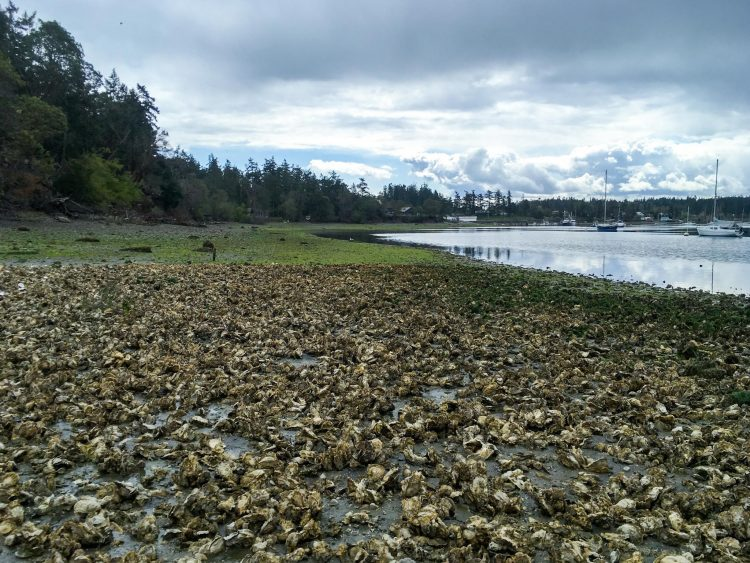May 4 2020
Currently, plastic pollution is a highly prevalent risk to marine life, one which can also have an impact on the food consumed by humans.
 An oyster bed during low tide at Mystery Bay State Park on Marrowstone Island in Puget Sound. Image Credit: Julieta Martinelli/University of Washington.
An oyster bed during low tide at Mystery Bay State Park on Marrowstone Island in Puget Sound. Image Credit: Julieta Martinelli/University of Washington.
Oysters, and other such shellfish that are economically valuable, tend to filter their food from the water that might also contain tiny microplastics. The accumulation and intake of these microplastics not just affect their health adversely but may also reach other animals, including humans, through the food chain.
In an interdisciplinary study performed recently, from the School of Aquatic and Fishery Sciences, Department of Chemistry and Department of Materials Science and Engineering of the University of Washington employed advanced techniques to precisely identify and catalog microplastics found in Pacific oysters from the Salish Sea.
The study findings show that the occurrence of tiny microplastic contaminants in these oysters is far lower than considered earlier. The results were reported in the Science of the Total Environment journal in January.
Until now, not a lot of chemical analysis has been done on microplastics in oysters. The microplastics that chemists have looked at in previous studies are slightly bigger and easy to visually recognize, but with oysters, the microplastics are much smaller and harder to identify.
Samantha Phan, Study Co-Author and Doctoral Student in Chemistry, University of Washington
As part of the study, wild Pacific oysters obtained from Washington’s state parks throughout the Salish Sea were sampled by the researchers. Standard processing techniques are used to dissolve the tissue of oysters, where the remaining solution is made to pass through a filter. All of the probable microplastic particles are collected by the filter.
“Observation of filters is the method researchers have typically used, so if we had stopped there, we would have thought all the oysters had microplastics because small particles were present in most of the filters,” stated Julieta Martinelli, the lead author of the study and a UW postdoctoral researcher at the School of Aquatic and Fishery Sciences.
Initial observations by Martinelli under a dissecting microscope showed what were considered to be high numbers of remnant microplastics in the testing filters. However, further analyses of the filters by Phan using three sophisticated chemical identification methods revealed that a major portion of the remnants in the filters was not really plastic.
When we’re characterizing plastics, or any polymers in chemistry in general, we have to use multiple techniques, and not every technique will give you a full picture. It’s half a picture or just part of the picture. When you put all those pictures and characterizations together, you can have a more complete understanding of what the composition or identities of these particles are.
Samantha Phan, Study Co-Author and Doctoral Student in Chemistry, University of Washington
During their analyses, the team realized that many of the particles were, in fact, shell fragments, minerals, salts and even fibers from the testing filters themselves. In the end, they found that only about 2% of the particles distilled from the oysters could be confirmed as plastics.
Most people so far have not used the combination of techniques or instruments that we used. It’s really easy to stop at the first part and say, ‘Oh, there’s a lot of particles here. They look like plastic. They must be plastic’. But when you actually go deeper into the chemical composition, they might not be.
Julieta Martinelli, Postdoctoral Researcher, School of Aquatic and Fishery Sciences, University of Washington
The number of plastic particles found by the researchers was comparatively low than the total number of particles analyzed. But they emphasize that while it seems that Pacific oysters are not gathering huge amounts of plastic, 40% of the particles observed could not be identified because of technical difficulties.
Moreover, the researchers admit that although a combination of instruments is the most comprehensive means for the analysis of these particles, higher costs, access to the equipment, and the excessive time-consuming nature of the study are factors that limit the widespread use.
Oysters are suspension feeders that pull in water and its constituents particles when they inhale. These particles are then sorted in and out of oysters through their gills. Earlier experiments have revealed that when microbeads or microfibers are given to oysters, they expel most of them either instantly or after a few hours.
The assumption is that the gill anatomy and physiology of oysters could be the reason why the researchers did not observe huge amounts of plastic accumulated in their samples.
“A lot of this has to do with how the oysters process water through their gills and how they get rid of particles,” stated Martinelli. “It doesn’t mean microplastics are not in the water, it means that the animals are better at expelling them.”
Thus, it has been proposed that in estuaries, suspension-feeding bivalves such as oysters could not be optimal indicators of pollution since they tend to naturally expel microplastics rather than ingesting them—good news for consumers who like to have oysters as food.
The other co-authors of the study are Christine Luscombe, a UW professor of materials science and engineering, and Jacqueline Padilla-Gamiño, a UW assistant professor of aquatic and fishery sciences. This study was funded by NOAA-SK and the Royal Research Fund awarded to Padilla-Gamiño.
Part of this study was performed at the Molecular Analysis Facility, a National Nanotechnology Coordinated Infrastructure site at the University of Washington supported in part by the National Science Foundation, the University of Washington, the Molecular Engineering & Sciences Institute and the Clean Energy Institute, and the Washington Research Foundation.
Journal Reference:
Martinelli, J. C., et al. (2020) Low incidence of microplastic contaminants in Pacific oysters (Crassostrea gigas Thunberg) from the Salish Sea, USA. Science of The Total Environment. doi.org/10.1016/j.scitotenv.2020.136826.